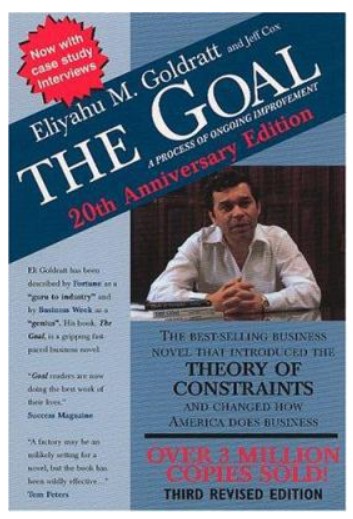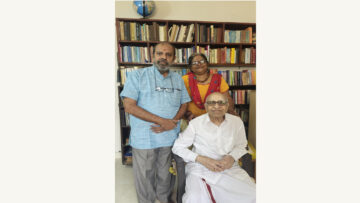Introduction
Growth and improvement are the twin engines of progress, fundamental drivers of advancement that affect every facet of our existence, from the personal evolution of an individual to the complex operations of a global corporation.
The most crucial step in any journey of improvement is a clear and honest assessment of where one stands.
A single question lies at the heart of this pursuit: “Where are we, and where do we need to go?”
Without a reliable compass, even the most ambitious efforts can lose their way.
For decades, the corporate world has relied on structured methodologies and frameworks to serve as this compass, providing a systematic way to evaluate current performance and plot a course for future success. These tools distill complex realities into a clear, multi-level hierarchy, transforming a vague desire for betterment into a tangible, step-by-step roadmap.
They are not just rigid checklists; they are a blend of qualitative factors and quantitative insights, offering an analytical and objective way to plan effective steps forward. I have often used them, in conjunction with tools like SWOT analysis, to assess corporate performance and guide them toward its long-term goals.
Early in my career, a colleague handed me a copy of Eliyahu Goldratt’s classic, The Goal. It wasn’t just a book; it was a guide to a new way of thinking about strategy.
Goldratt’s work profoundly influenced how the world’s leading firms approach problem-solving – a structured process that starts with a clear-eyed evaluation of the current state, defines a desirable target state, and then meticulously builds a roadmap to bridge the gap.
This methodology became a core part of my skillset, shaping my approach to strategic assessments and problem-solving.
Over time, I began to see its potential reaching far beyond the corporate world. I realized this framework could be applied to a completely different domain, one that deals not just with profit and efficiency, but with purpose and righteousness.
Over the last decade, we have witnessed a powerful and unprecedented proliferation of activities in the advancement of Indic narratives. From grassroots movements and digital media initiatives to academic centers and cultural organizations, the energy dedicated to this space has never been higher.
However, despite this surge in effort, I grew increasingly concerned by the fragmented and often-ineffective nature of these initiatives. It was this very realization that led me to propose a strategic framework for Indic renaissance in this article written a few years ago to counter the Euro-centric view of India. This strategic framework is the foundational blueprint for a cohesive Indic movement, and this Dharmic Maturity Model is designed as its essential operational tool. For a comprehensive understanding of the vision behind this proposal, I strongly encourage you to read the original article, as it will provide the necessary context for the model’s implementation.
(Figure 1: Phased approach for Indic Renaissance)
In this article I outlined a five-phase approach to promote Indic narratives – from defining objectives to building a scholarly ecosystem and developing a long-term roadmap. The article highlighted the potential for a collaborative and cohesive approach to Indic renaissance, emphasizing the importance of applying such structured methodologies in a dharmic context.
Few organizations have recently emerged, adopting a corporate approach to Indic renaissance by applying professional rigor to areas like history research and the advancement of Indic knowledge systems.
This effort signifies a crucial shift from fragmented initiatives to a more cohesive approach.
The strategic framework I had proposed in the article can be invaluable for the many scholars, researchers, and organizations actively engaged in historical research and narrative building today. For those tirelessly working to unearth and disseminate authentic knowledge, this provides a structured way to assess their current efforts and identify specific gaps in their approach to ensure their work not only contributes to the Indic narrative but does so with a proven, systematic rigor.
It is from this experience and context that I am now proposing to take the next logical step – to develop a Dharmic Maturity Model.
The purpose of the model is to quantify dharmic sensibilities and, in doing so, provide a way to assess the “dharmic score” of individuals, organizations, AI tools, and public narratives. By understanding and applying this model, we can build on principles already proven in corporate settings to create a new way to measure and advance what truly matters.
To effectively implement this model, it is essential to understand its structure and application, which builds on the principles of maturity models already proven in corporate settings.
Understanding the Maturity Model
At its core, a maturity model is a structured diagnostic tool used to assess an entity’s current state of performance in a specific area and to provide a roadmap for improvement.
Think of it as a progress bar for a skill or capability. It doesn’t just tell you if you’re good or bad; it tells you exactly where you are on a journey from beginner to expert.
It offers a clear understanding of capabilities and a progression path for improvement and development.
There are scores of maturity models available, though the standard ones, widely used, typically feature five levels: Initial, Repeatable, Controlled, Managed and Optimized.
While the names may vary, these levels typically represent a progression from chaos to mastery.
(Figure 2: Maturity Model Levels)
- Level 1 (Initial): The beginning stage. Capabilities are chaotic, disorganized, and reactive.
- Level 2 (Repeatable): Some foundational capabilities are emerging. The entity can repeat past successes, at times.
- Level 3 (Controlled): Capability is well defined. Success is no longer dependent on individuals; it is built into the system.
- Level 4 (Managed): The entity uses data and metrics to control and measure capabilities. Performance is predictable and can be quantitatively assessed, allowing for sophisticated analysis and control.
- Level 5 (Optimized): This is the pinnacle of maturity. The entity is focused on continuous improvement and innovation. Capabilities are not just managed; they are actively and iteratively improved to meet evolving needs.
The model integrates both qualitative insights and quantitative metrics to provide a comprehensive evaluation, with assessment methods including self-evaluations, peer reviews, and data analysis to measure progress across these stages.
Maturity models can be applied to virtually any business function, from supply chains to customer relationship management (CRM). They provide a common language and a shared vision for growth, turning an abstract desire for “getting better” into a tangible, actionable plan.
This proven methodology, which has driven strategic success in the corporate world for decades, forms the bedrock of my proposal for a Dharmic Maturity Model.
The Dharmic Maturity Model
The Dharmic Maturity Model is a multi-dimensional framework designed to assess an entity’s effectiveness to contribute to the Indic renaissance. The proposed model measures maturity across five distinct dimensions, which are initial proposals representing the key axes of assessment for an entity’s maturity in the Indic renaissance. The dimensions are adopted from a speech given by Shri Annamalai, former TN BJP Chief a few years ago. They are:
- Eliminating Misconceptions: This dimension measures the entity’s ability to counter inaccurate beliefs and historical fallacies.
- Rediscovering Culture: This dimension assesses the effort to unearth and document authentic, often-forgotten knowledge and sources.
- Restoring Culture: This dimension evaluates the entity’s success in reconstructing and preserving fragmented traditions.
- Practicing Culture: This dimension measures the effectiveness in encouraging the tangible, lived application of dharmic principles.
- Popularizing Culture: This dimension assesses the ability to disseminate authentic culture to a broad, modern audience without dilution.
To transform this into a practical assessment tool, these dimensions must be expanded to identify a list of specific, measurable capabilities that can be assessed. A dimension is at a high-level; it’s the series of capabilities under each dimension that need to be measured and assessed. The maturity levels will be applied to these capabilities, providing a granular and precise scorecard for an entity’s performance.
Sample Capabilities
Sample capabilities for each dimension is provided to help the reader think through this in greater detail. This is just a sample for reference, and by no means exhaustive. These are specific, measurable actions that would be assessed to determine an entity’s maturity level within each dimension.
- Eliminating Misconceptions
- Misinformation Tracking: The ability to use analytics and tools to identify and monitor the spread of falsehoods within a specific domain.
- Fact-Checking Protocol: The presence of a standardized, verifiable process for confirming information before publication.
- Source Verification & Citation Standards: The consistent practice of referencing primary or authoritative secondary sources in all content to build credibility.
- Rediscovering Culture
- Foundational Research: The ability to conduct original, in-depth academic research that unearths previously unknown or misunderstood aspects of culture.
- Archival & Documentation: The capability to systematically discover, organize, and digitize ancient manuscripts, oral traditions, and artifacts.
- Translational Rigor: The use of certified scholars or linguistic experts to produce accurate, nuanced translations of ancient texts.
- Restoring Culture
- Authentic Reconstruction: The capability to use historical sources and scholarly guidance to accurately rebuild or revive a fragmented tradition, such as a classical art form or a historical site.
- Skill Preservation & Mentorship: The presence of a structured program to train a new generation in traditional skills, ensuring their continuity.
- Material Preservation: The application of proven techniques for the physical preservation of cultural artifacts, manuscripts, and artistic works.
- Practicing Culture
- Ethical Operational Policy: The integration of dharmic principles into a business’s or organization’s core operations, such as honest attribution and factual assessment.
- Actionable Guidance: The ability to provide clear, practical steps that enable an audience to apply a specific cultural or philosophical concept in their daily lives.
- Community Building: The effectiveness of initiatives designed to foster a sense of shared purpose for a Hindu ecosystem.
- Popularizing Culture
- Content Strategy: The capability to develop and execute a plan for creating engaging, shareable content that makes complex ideas accessible to a mainstream audience.
- Audience Engagement Analytics: The use of data to measure how an audience interacts with content and the ability to refine strategy based on that feedback.
- Cultural Integrity: The presence of a clear process to ensure that content created for a mass audience does not dilute, distort, or misrepresent the authentic essence of the culture.
To determine a dimension’s maturity, each of its specific capabilities is first assessed against the five-level scale (Initial, Repeating, Controlled, Managed, and Optimized). For example, under the Eliminating Misconceptions dimension, an entity’s Fact-Checking Protocol capability is assigned a score based on its maturity, from a Level 1 (no protocol) to a Level 5 (globally recognized standard). Once each of the dimension’s capabilities has been individually scored, these results are aggregated to yield a single, overall maturity score for the entire dimension. This aggregation can be a simple average, or it can be a weighted average, with more critical capabilities given higher importance. This two-step process provides a powerful, objective assessment – the single score for the dimension offers a clear, top-level understanding of maturity, while the granular data from each capability provides the precise diagnostic information needed for a targeted roadmap to improvement.
Measuring maturity for each dimension requires a systematic and comprehensive assessment, utilizing both qualitative insights and quantitative metrics. The process would begin with a self-evaluation, where an entity’s dimensions and capabilities are assessed as mentioned earlier. This would be followed by peer reviews and expert evaluations, where a panel of scholars, practitioners, or cultural leaders assess the entity’s work for its intellectual honesty, authenticity, and impact. For dimensions like Eliminating Misconceptions or Popularizing Culture, quantitative metrics are crucial; this can involve tracking the reach and engagement of a campaign, measuring changes in audience understanding through surveys, or analyzing the spread of accurate information. For others, such as Rediscovering Culture, success might be measured by the number of original sources unearthed or the scholarly consensus on their authenticity. This multi-faceted assessment yields a clear scorecard, providing a precise “dharmic score” for each dimension and enabling the entity to pinpoint areas of strength and weakness for a targeted roadmap to higher maturity.
Sample Applications
The model can be applied to a diverse array of entities, providing a tailored assessment for each.
- Articles, Research Papers, and Books
These artifacts can be measured as a primary output of scholarly or creative effort. For example, a research paper’s score would be driven by its maturity in Eliminating Misconceptions and Rediscovering Culture, by assessing its intellectual honesty and reliance on primary sources. A book’s score could be heavily influenced by its maturity in Practicing Culture if it provides an actionable guide for living, or Popularizing Culture if it successfully makes complex ideas accessible to a general audience.
- GenAI Tools
As powerful and rapidly evolving artifacts, GenAI tools can be evaluated as a new frontier for dharmic application. Their maturity would be measured by their ability to not only avoid propagating misinformation (Eliminating Misconceptions) but also to serve as a catalyst for cultural popularization by generating accurate and engaging content for a wide audience. The model provides a critical ethical framework for their development, ensuring they are aligned with purpose and righteousness.
- People/Scholars
The model can be applied to assess the overall body of work of an individual. A scholar’s maturity score would reflect their mastery in dimensions like Rediscovering Culture (based on the rigor and originality of their research) and Eliminating Misconceptions (based on their efforts to combat historical falsehoods). Their overall score would serve as a qualitative measure of their contribution to the Indic renaissance and their personal Svadharma (purposeful work).
By providing a clear set of metrics for each of these entities, the Dharmic Maturity Model becomes a versatile and powerful tool for measurement, diagnosis, and strategic planning, making it a critical asset in advancing the Indic narrative.
Applying the Model in Practice
To fully understand how the Dharmic Maturity Model functions, it’s helpful to walk through a few example use cases that assess an entity across multiple capabilities and dimensions. This process moves from scoring specific capabilities to aggregating those scores for a holistic dimension-level assessment.
Use Case 1: Assessing a Digital Media Organization
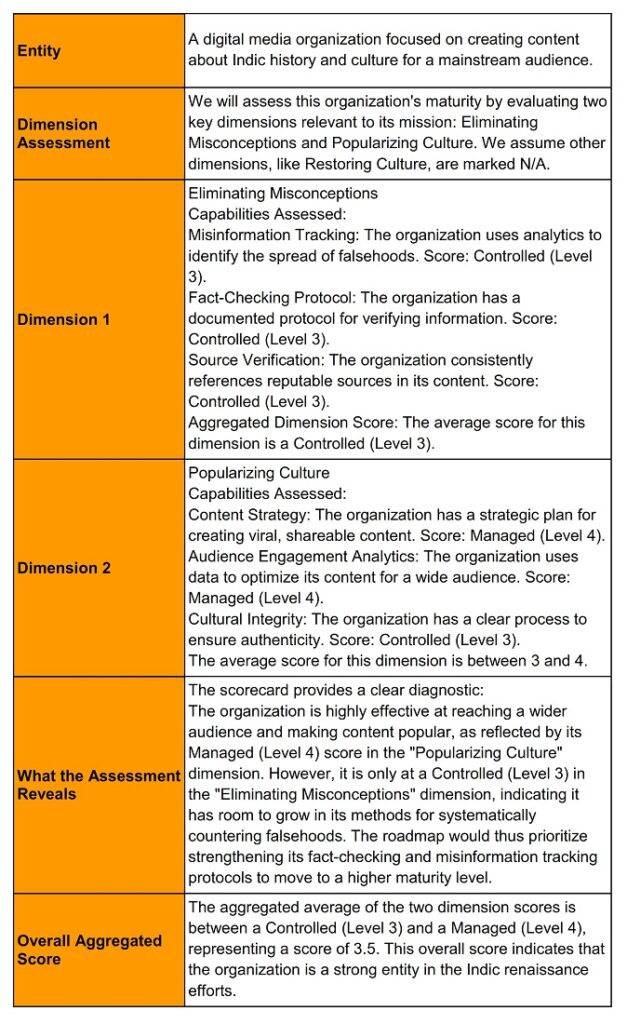 Use Case 2: Evaluating a Cultural Foundation
Use Case 2: Evaluating a Cultural Foundation
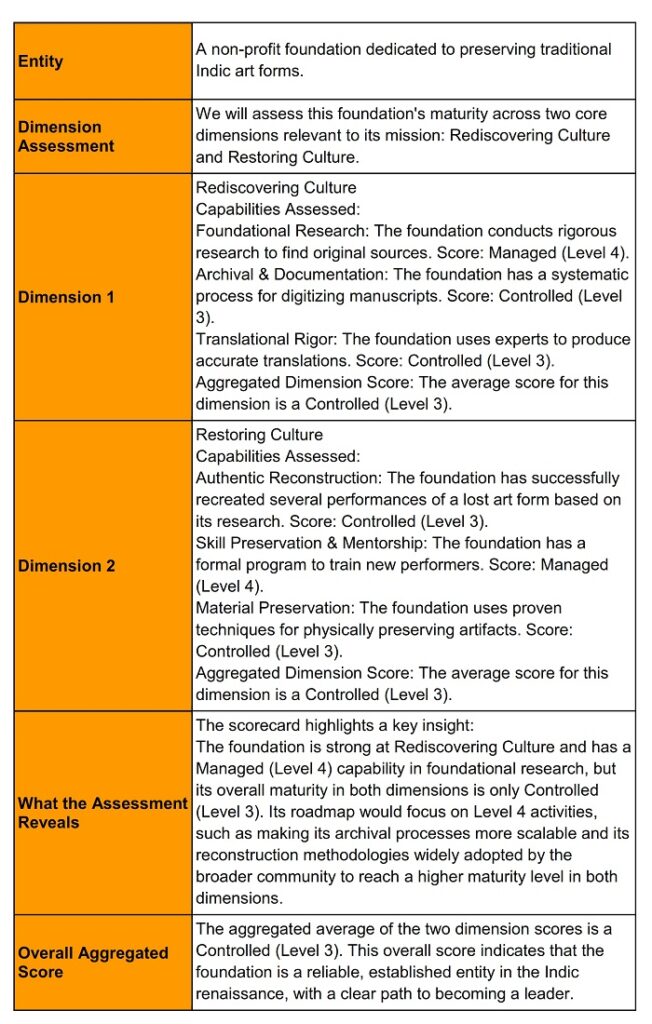 Use Case 3: Scoring a Scholar-Activist
Use Case 3: Scoring a Scholar-Activist
Use Case 4: Evaluating a Gen AI Model
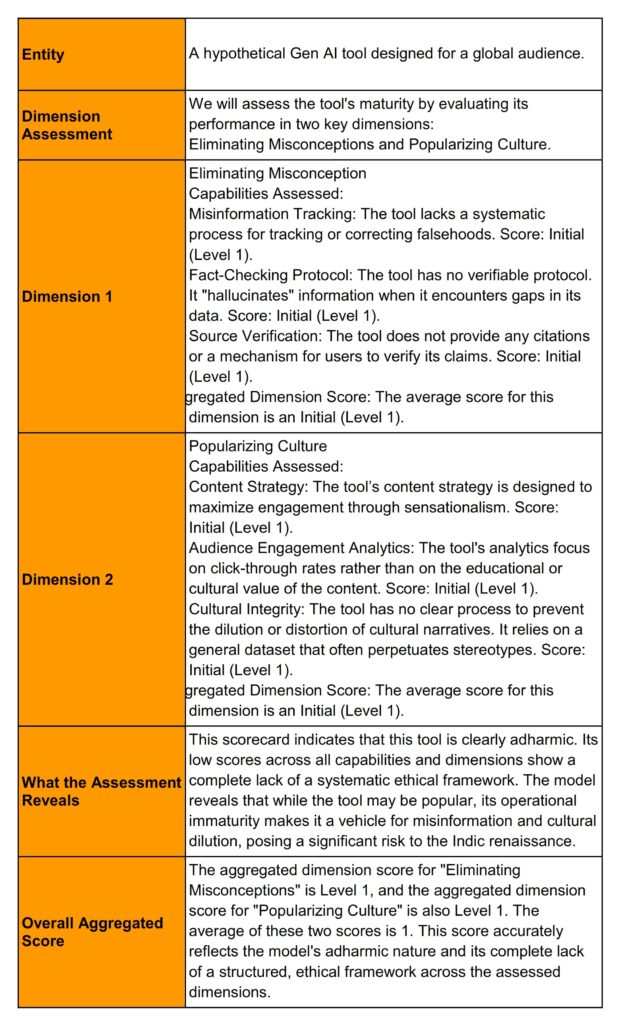 Operationalizing the Strategic Framework
Operationalizing the Strategic Framework
The Dharmic Maturity Model is designed to provide the essential diagnostic and planning tools needed to operationalize the strategic framework for a broad Indic renaissance that was proposed in this article. I welcome you to read this article to understand the framework, if you haven’t yet done so.
The model’s core purpose is to fit seamlessly into the larger strategy by offering a flexible and adaptable approach to assessment. While the initial/proposed dimensions serve as a starting point, they are intentionally designed to be expanded to meet varying needs of Indic organizations.
In this context, the model’s adaptability also allows for the integration of critical tools, such as the innovative Svayambodha-Shatrubodha scale proposed by noted Dharmic activist and author Pankaj Saxena. In his landmark book Svayambodha and Shatrubodha, A Hindu View of Self and the World (BlueOne Ink, 2025), the author proposes a scale to distinguish and measure a defensive, enemy-aware posture and a confident, self-aware one.
It is important to note here that the dimensions and capabilities are not a static prescription. Instead, they can be customized based on the specific objectives that are set forth. This dynamic, objective-driven approach is where the flexible Dharmic Maturity Model truly helps, ensuring that the framework is always a relevant and powerful tool for strategic planning.
This customization is guided by a clear hierarchy: Overarching Objectives define strategic Needs. These needs, in turn, guide the selection of the most relevant Dimensions (either from the proposed set or new ones created as needed). Finally, for each chosen dimension, a specific list of measurable Capabilities is identified for assessment. This dynamic, objective-driven approach ensures that the framework is always a relevant and powerful tool for strategic planning.
This flexible framework connects high-level objectives to the layers of the Dharmic Maturity Model as follows:
- Supports Phase 3 (SWOT Analysis & Current State Assessment): The strategic framework calls for a thorough assessment of the Indic landscape to identify strengths and weaknesses. The Dharmic Maturity Model provides the precise mechanism for this. Its five dimensions serve as the key axes for a systematic evaluation, while the granular assessment of specific capabilities within each dimension provides the data points needed to pinpoint where efforts are fragmented or lacking. This moves the assessment from being anecdotal to being data-driven and objective, providing the crucial “S” and “W” of a SWOT analysis.
- Guides Phase 4 (Determining Target State & Gap Analysis): The framework emphasizes the need to define a target state and bridge the gap. The Dharmic Maturity Model provides the qualitative and quantitative benchmarks to do this with precision. The five-level maturity scale provides a clear progression path. Instead of a vague goal of “doing better,” an entity can set a tangible objective, for example, moving from a Controlled to a Managed level in its “Fact-Checking Protocol” capability. The gap analysis becomes a simple matter of identifying the distance between the current and desired maturity levels on the model’s scorecard.
- Informs Phase 5 (Developing a Long-Term Roadmap): The final phase of the strategic framework is to develop a long-term, multi-decade roadmap. The Dharmic Maturity Model provides the detailed content for this roadmap. The five dimensions act as the pillars for action, with each capability and maturity level providing a step-by-step plan for progress. The model provides a unified language for this, fostering the cohesion and collaboration that your original article identified as critical for a purposeful and lasting renaissance.
In essence, the Dharmic Maturity Model is the missing link that translates a high-level strategic vision into a practical, actionable plan for a vibrant and evolving Indic civilization.
Conclusion
The Dharmic Maturity Model’s true legacy, therefore, lies not just in its individual assessments, but in its potential to unite and direct the entire Indic renaissance.
This writeup is intended as an initial proposal. Perhaps there is an opportunity to define a standardized Dharmic Maturity Model that can be adopted and used widely across the Indic ecosystem. (The author wishes to declare his interest in pursuing research on this topic in the near future.)
The proposal provides the mechanism to achieve the strategic framework’s most ambitious objectives – the shift from a fragmented, defensive movement to a cohesive, proactive, and purposeful force. By providing a common scorecard for scholarly rigor, cultural restoration, and public outreach, the model ensures that all efforts, from the academic to the grassroots, are systematically aligned.
This framework represents a profound confluence of thought, marrying the modern rigor of corporate strategy with the needs of Indic renaissance. While the model provides a highly analytical and data-driven approach, its ultimate goal is to serve a purpose far beyond metrics – to build a lasting and meaningful legacy based on authenticity and integrity.
In this way, it transforms the abstract goal of a revitalized civilization into a tangible reality, giving the Indic renaissance the structure, coherence, and measurable progress it needs to win the narrative war and firmly establish its place in the world.
Disclaimer: The opinions expressed in this article belong to the author. Indic Today is neither responsible nor liable for the accuracy, completeness, suitability, or validity of any information in the article.


